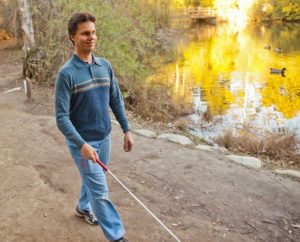Sonar – Part 5
 For a few months now, we’ve reviewed the wonder of echolocation in animals. We conclude the series this month by discussing echolocation in humans. Can a person actually “see” by sound alone? For centuries it has been known that certain blind people gain information about their environment by snapping their fingers, tapping the floor with their shoes, or clicking with their mouth. Sharp clicks return an echo that activates the visual processing parts of their brain and creates a 3d image of the environment. This technique doesn’t provide the blind person with fine details, but it is certainly helpful to know if there is a large obstruction (like a tree or a car) in the way. In recent times, the clicking to echolocate technique has been popularized by a California man named Daniel Kish (above). He likens the clicking technique to getting sticky peanut butter off the roof of your mouth. Daniel has perfected echolocation to the point that he can tell you the dimensions of a pole near him, duck under a low tree limb, and even describe the texture of the tree’s trunk. He can do some things that seeing people cannot, like observing things behind him and “seeing” through walls. Check out the online video of Daniel riding his bike down the street! In recent times, classes on echolocation have become available for both seeing and blind students. Instructors can train a blind person to echolocate in just 10 weeks, dramatically changing their quality of life. Perhaps we could all learn to be more perceptive and take the time to really listen well. Jesus instructed his followers, “He that hath ears to hear, let him hear” (Matthew 11:15).
For a few months now, we’ve reviewed the wonder of echolocation in animals. We conclude the series this month by discussing echolocation in humans. Can a person actually “see” by sound alone? For centuries it has been known that certain blind people gain information about their environment by snapping their fingers, tapping the floor with their shoes, or clicking with their mouth. Sharp clicks return an echo that activates the visual processing parts of their brain and creates a 3d image of the environment. This technique doesn’t provide the blind person with fine details, but it is certainly helpful to know if there is a large obstruction (like a tree or a car) in the way. In recent times, the clicking to echolocate technique has been popularized by a California man named Daniel Kish (above). He likens the clicking technique to getting sticky peanut butter off the roof of your mouth. Daniel has perfected echolocation to the point that he can tell you the dimensions of a pole near him, duck under a low tree limb, and even describe the texture of the tree’s trunk. He can do some things that seeing people cannot, like observing things behind him and “seeing” through walls. Check out the online video of Daniel riding his bike down the street! In recent times, classes on echolocation have become available for both seeing and blind students. Instructors can train a blind person to echolocate in just 10 weeks, dramatically changing their quality of life. Perhaps we could all learn to be more perceptive and take the time to really listen well. Jesus instructed his followers, “He that hath ears to hear, let him hear” (Matthew 11:15).
Posted on March 2, 2023 by dwoetzel.
